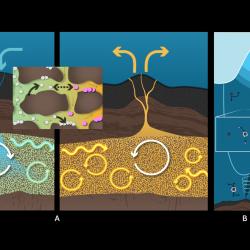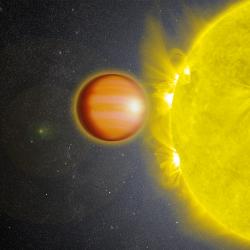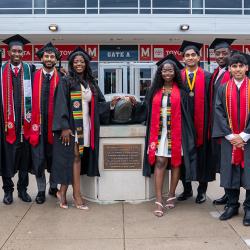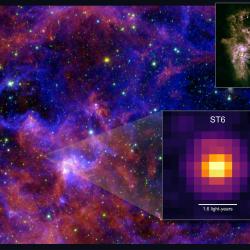Exoplanet Explorer Helps Astronomers See the Unseeable
UMD astronomy Ph.D. student Ellis Bogat’s work on NASA’s Roman telescope will help researchers see exoplanets hidden in the glare of distant stars.

Millions of times fainter than their parent stars, exoplanets are like cosmic needles in a celestial haystack. While astronomers have discovered many distant planets outside our solar system, seeing and studying them directly remains extraordinarily difficult. That’s where University of Maryland astronomy Ph.D. student Ellis Bogat comes in.
As a member of NASA’s Nancy Grace Roman Space Telescope team, Bogat helps to develop sophisticated technology that will allow astronomers to directly photograph distant worlds that have remained hidden in the glare of their stars until now. Set to launch into the sun-Earth orbit by May 2027, the Roman telescope will be able to look at a patch of sky 100 times larger than both the Hubble Space Telescope and James Webb Space Telescope can—and ultimately revolutionize how scientists discover and study distant worlds.
“I’m part of a massive collaborative effort to transform the Roman telescope’s raw signals into meaningful data,” Bogat said. “Because it’ll be looking at such faint objects, there’s a lot of noise to parse through. When you get raw data from a space telescope, there’s a ton of calibration needed, so it’s our goal to develop a data pipeline that can mathematically interpret these signals so we can see what’s actually happening up in the sky.”
Bogat’s work focuses specifically on the Roman Space Telescope’s Coronagraph Instrument —a device originally invented to study the sun’s corona, the faint outermost layer of the sun’s atmosphere. The technology has now been adapted to observe distant stars and the faint light of their orbiting planets.
“You can think of a coronagraph as a series of physical masks that filter out bright starlight in the center of an image but allow dim light from nearby to pass through a camera,” Bogat explained. “Blocking out the star’s light will make it possible for us to see objects that would otherwise be hidden in the brightness.”
Stars typically outshine their planet counterparts by a factor of at least one million, making direct observation nearly impossible without specialized tools. Previous coronagraph technology has successfully imaged only the largest gas giant exoplanets, but Bogat hopes that the Roman coronagraph will reveal smaller, eventually even Earth-like planets.
“This project will let us start being able to image smaller and more distant planets than ever,” Bogat noted. “In addition to finding new celestial bodies beyond our solar system, we’ll also be able to confirm the existence of several exoplanets that we suspect exist via indirect measurements from previous missions.”

For Bogat, the Roman Coronagraph represents the next big step in learning how different other planetary systems are from the one Earth belongs to. Their work with the project’s data pipeline will also narrow down targets for scientists to study during the mission, because time and resources to closely observe exoplanets will be limited.
“There are systems with planets in crazy alignments relative to each other and to their star, at least if we’re using the rules we think apply to the planets and stars in our solar system,” Bogat explained. “There’s evidence that what we think we know might not be a rule at all. Exoplanet discoveries are regularly forcing us to reconsider how planetary systems form and evolve over time.”
Learning the art of astronomy
Long before Bogat wrote code for next-generation telescopes, they contemplated a very different career trajectory.
“Growing up, I was in love with both art and astronomy,” Bogat explained. “When I was applying to college, I was determined to go to art school and become a painter at first. But my desire to problem-solve and explore space won out in the end.”
That decision led Bogat to the University of Texas, where they earned a degree in physics and astronomy. After graduation, Bogat landed a position at NASA headquarters working on Mars exploration, planning and analyzing what scientists would need to learn about the Martian environment to be able to send humans there (and back) safely.
“It was pretty high-level strategic work, closer to what you’d think of as science policy. We were coming up with the major scientific questions we wanted to explore about the history of the Martian environment,” Bogat explained. “It was interesting, but I wanted to be involved in specific research projects, doing the nitty-gritty data analysis—actually being the one to answer those questions.”

Inspired to dig deeper in 2021, Bogat began to work with direct imaging technology and exoplanetary science at NASA’s Goddard Space Flight Center under research astrophysicists Neil Zimmerman and Joshua Schlieder and at UMD with former Astronomy Assistant Professor Thaddeus Komacek’s ExoBUGS research group. In doing so, Bogat began to see new parallels between their work in astronomy and their experience as an artist. Like chiaroscuro, a Renaissance art technique that uses strong contrasts between light and dark to add dimension to paintings, Bogat manipulates light and shadow to reveal what’s hidden. The methods that shaped oil paintings now shape algorithms designed to pull important planetary data from cosmic noise.
“Instead of adding shadows to make something stand out, we’re removing overwhelming light to reveal the faint planets that would otherwise remain invisible,” Bogat explained. “The ultimate goal of direct-imaging is to eventually take an image of an Earth-like planet orbiting a sun-like star and to see the bigger picture of how stars and planets work beyond our solar system.”
As the countdown to the Roman Space Telescope’s launch by 2027 continues, Bogat will continue pushing their science and art projects forward.
“I’m working on astronomy comics that summarize new papers at a more accessible level,” Bogat said. “There is so much that we’re finding out in space that’s relevant to how Earth’s become what it is today. Figuring out how planets are born, how solar systems evolve—it’s all a team effort so it’s important to get this information out there.”







